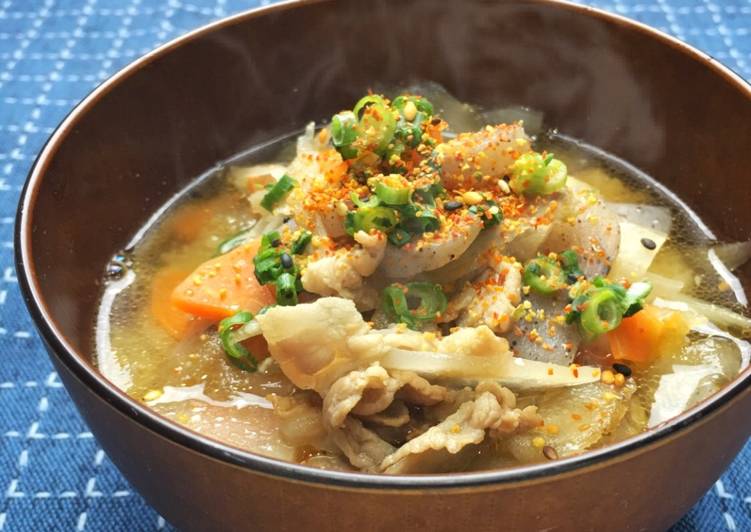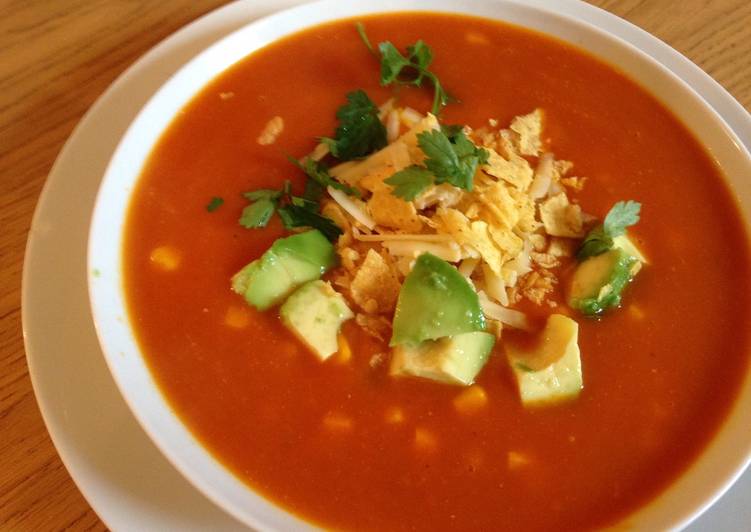
Hello everybody, hope you’re having an amazing day today. Today, I’m gonna show you how to prepare a distinctive dish, tonjiru (pork miso soup). One of my favorites. This time, I will make it a little bit unique. This will be really delicious.
Tonjiru is a savory miso soup with pork and root vegetables. Packed with an excellent source of vitamins, it's absolutely nourishing and soul-fulfilling! If you ask me what is my favorite miso soup, I would immediately say Tonjiru (豚汁).
Tonjiru (Pork miso soup) is one of the most popular of recent trending foods in the world. It is simple, it is quick, it tastes yummy. It is appreciated by millions daily. They are nice and they look wonderful. Tonjiru (Pork miso soup) is something that I’ve loved my whole life.
To begin with this recipe, we have to prepare a few ingredients. You can cook tonjiru (pork miso soup) using 11 ingredients and 14 steps. Here is how you cook it.
The ingredients needed to make Tonjiru (Pork miso soup):
- Prepare 200 g thinly sliced pork belly
- Make ready 200 g daikon radish
- Take 100 g carrot
- Take 150 g burdock root
- Get 150 g konnyaku
- Get 1 spring onion
- Make ready 120 ml dashi stock
- Prepare 100 g miso
- Make ready 2 teaspoon soy sauce
- Take Thinly sliced green onion (garnish)
- Prepare 7 spice chili power (optional)
Compared to normal miso soup, tonjiru tend to be more substantial, with a larger quantity and variety of ingredients added to the soup. Tonjiru (or Butajiru) is a kind of Miso Soup with pork and a lot of root vegetables such as Gobo (burdock root) and carrot. Even though it is a Miso soup, Tonjiru tastes very different from ordinary Miso Soup. Combining flavorful ingredients like pork belly and shiitake mushrooms with classic Japanese seasonings like mirin and dashi, this hearty tonjiru soup will delight friends and family when you whip it up in your home kitchen.
Steps to make Tonjiru (Pork miso soup):
- Peel the dikon radish and carrot.
- Cut the dikon radish and carrot into quarters lengthwise and then cut into thin slices.
- Wash the burdock root well, then scrape the skin with the back of a knife. Don’t peel the burdock too much as the part just under the skin contains a lot of nutrients and flavor.
- Make several long shallow cuts lengthwise all the way around the burdock root.
- Shave the burdock root into small strips over cold water and soak them for about 5 minutes to remove bitterness, then drain.
- Cut spring onion into 2 cm long pieces.
- Cut the konnyaku into thin short strips.
- Cut the pork belly into 3 cm thick slices.
- Heat the pan over medium-high heat, place vegetable oil and then add the pork and sauté well.
- Add the dikon, carrot, burdock root, spring onion and konnyaku and stir-fry.
- Once the fat from the pork is evenly coating the vegetables, add the dashi stock and simmer, skimming occasionally.
- Once the vegetables become tender, add the miso by dissolving it in a miso strainer or a ladle with some of the soup until no lumps remain.
- Add a 1 teaspoon of soy sauce.
- Serve the miso soup in a bowl, and then sprinkle thinly sliced green onion and seven spice chili powder (shichimi tougarashi) according to your preference.
Tonjiru is like an upgraded, meatier version of classic miso soup. This tonjiru recipe combines miso soup with sliced pork and root vegetables for a hearty and filling soup meal that is quick and easy to prepare. Warm yourself up during the winter with this easy tonjiru pork soup recipe. Tonjiru is a classic winter dish of slowly stewed slices of pork mixed with. We are making healthy, nutritious Tonjiru, pork miso soup with lots of vegetables.
So that’s going to wrap it up with this special food tonjiru (pork miso soup) recipe. Thanks so much for your time. I’m confident that you can make this at home. There is gonna be more interesting food at home recipes coming up. Don’t forget to save this page on your browser, and share it to your family, friends and colleague. Thanks again for reading. Go on get cooking!


